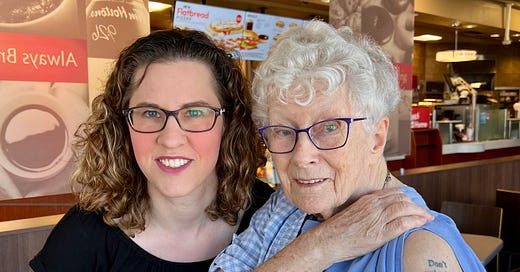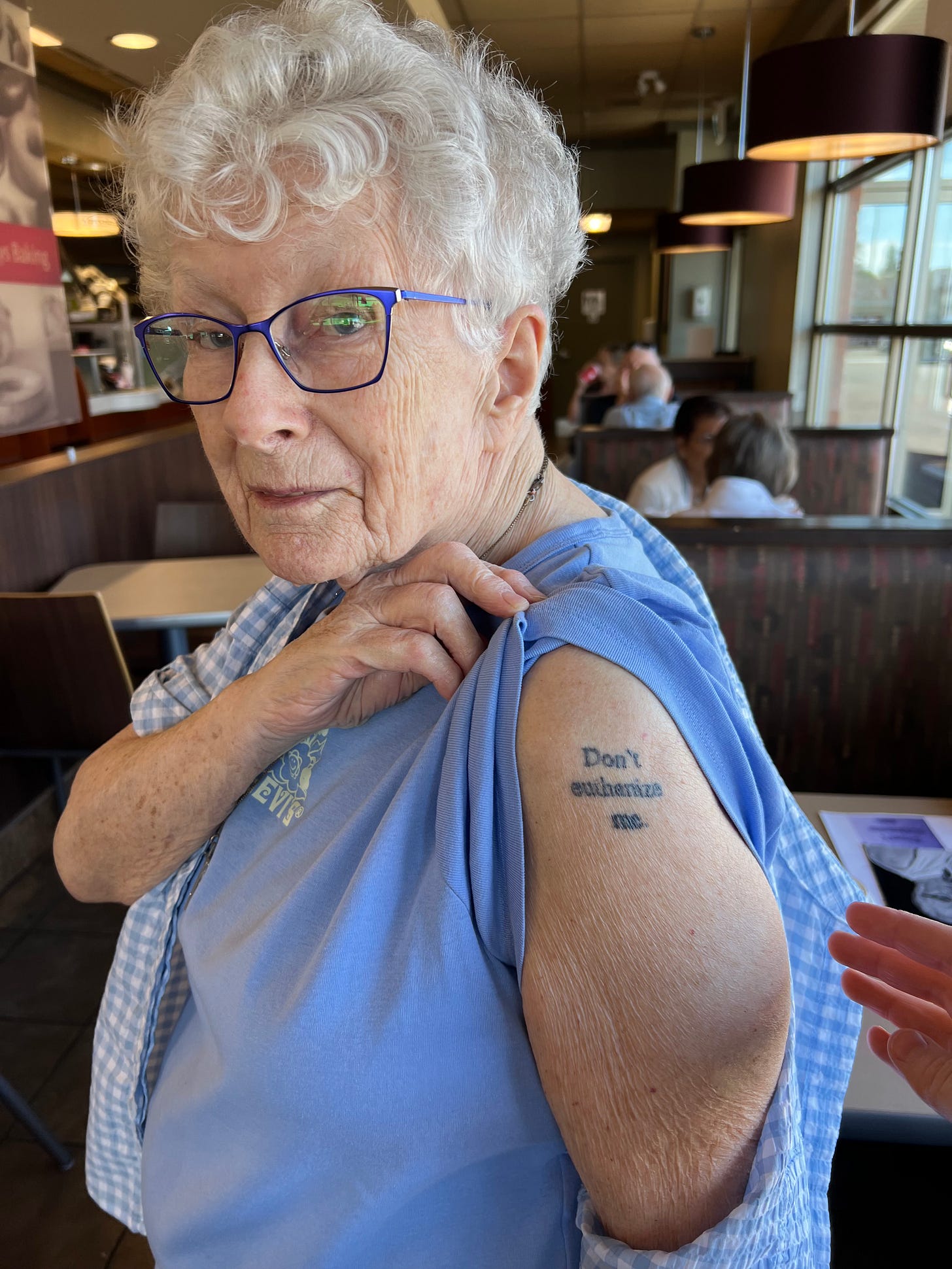“I suppose you could call me an old-fashioned woman,” began Calgarian Christine Nagel. “I always discouraged my children from getting tattoos.”
You can imagine how taken aback, then, Christine’s children were when she announced that she was getting her first tattoo at age 81. Perhaps the only thing more startling was that she had chosen that it would say: “Don’t euthanize me.”
“Why are you getting that?” they asked.
Christine told them, “Because the government passed a bill that is a way to eradicate human life, but human life is a gift from God. We don’t decide when it begins; no more do we decide when it ends.”
The impetus for getting the tattoo partially hearkened back to wartime childhood memories. Born and raised in England, Christine was four when the Second World War began and 10 when it ended. She remembered the mandatory blackouts as well as classmates who lost parents during the war, saying: “There were German bombs dropping down and we couldn’t let out a chink of light. The civilian attitude was to obey rules to preserve life. And, particularly given the constant threat, the grownups I knew carried cards that said: “I’m a Catholic. In case of accident, call a priest.”
Pausing for a moment to marvel at her own recollection of these facts, she observed, “When you get older, you can’t remember what you had for breakfast but you can remember what happened when you were four.”
While the overall wartime context certainly heightened Christine’s sensitivity to suffering, there were many personal experiences of suffering throughout this octogenarian’s life, too:
“I know that suffering is a part of life, it’s a part of living,” Christine told me. “And I believe that everybody suffers in one way or another. I watched my mother suffer and die from ALS when she was 34. I suffered myself when she died and I was only 10. At the time, in the 1940s, it was not expected that children should go to funerals and my siblings and I were not told anything about our mother’s death until a few months later.”
After the war, Christine’s father remarried. Then, her stepmother’s mother began to indicate to Christine and her siblings that they were an unnecessary burden on his second wife. This situation led to Christine feeling for years like did not have a home and so, as an adult, she seized the opportunity to move to Canada and make one.
Christine settled in a small village in Saskatchewan to teach and eventually met and married a local farmer. On discovering that they were unable to have children, they chose to adopt. She had been particularly inspired to adopt by St. Thomas More’s example, which she read about in a book entitled, Two Fortunate Orphans.
Over the years, the couple adopted seven children – including three Indigenous children – all of whose birth mothers had specifically requested a Catholic upbringing for them.
Asked what she thinks has changed with respect to the modern inability to contend with the trials of life, Christine told me, “There was so much suffering and death that people would hardly think of cutting life short intentionally. But now, the Western world has become more and more affluent and suffering is not so apparent. People feel entitled to have a life based on F-U-N. It’s got to be fun or else it’s not worth it. We always ask the children, ‘Did you have fun?’ And adults tell each other, ‘Oh, that was such fun!’ Fun has become the goal of life. But life isn’t always fun; life has suffering. Life is a pit stop on the way to heaven.”
And so, with the nationwide legalization of euthanasia in Canada, Christine remembered those wartime cards to “Phone a priest” and briefly considered carrying a card in her wallet that would say, “I’m a Catholic, don’t euthanize me.”
“But,” explained Christine, “knowing myself, I needed something more solid than a card because I traditionally lose things. I decided that a tattoo would last me until my death and would be a permanent feature.”
And so, Christine went to get tattooed and her kids came to watch.
Since the tattoo is on her upper arm, it could be easily spotted when she was in the pool. “When I was taking swimming lessons,” she said, “people were curious and positive about it. In fact, I’ve never met anyone who wasn’t positive about it. When I was in the hospital, doctors and nurses would run and fetch one another to come and see it and doctors always gave a thumbs up as they walked by.”
Nevertheless, she recognizes that those supportive reactions might become fewer as euthanasia becomes more common in Canada and she speculates that, if certain doctors and nurses support euthanasia, they probably would not say so to her.
And so, I asked Christine whether she sees the tattoo more for others or for herself.
She answered, “This tattoo reminds me of my own value personally. It gives me the message that I don’t want my life cut short and I don’t want anybody's else’s life cut short. Nobody has a right to destroy life. The person may not be so smart or so good-looking or have such a high ‘quality of life’, but the quality of life that God gives to each person is the same for everybody.”
Christine notes that even were she to be in a serious car accident or to end up in a so-called vegetative state, the message would still remain on her skin and, she says, “I don’t want to be kept alive mechanically, but I do want to die naturally because suffering doesn’t stop us from continuing our race to heaven.”
It has been several years since Christine got the tattoo, so I asked Christine if she has had any regrets at all about it.
“Initially, I thought about getting the tattoo across my chest, but given the number of people who ask to see it, it’s good I went with my arm instead!” she chuckled.
How do you give expression to values in an enduring way?
Are there any statements that you want to affirm permanently?




